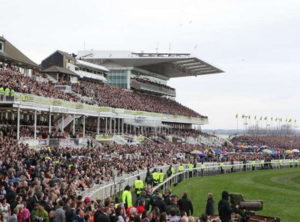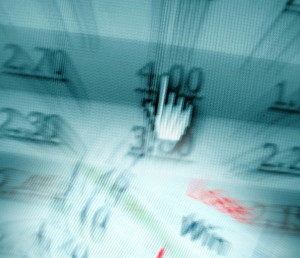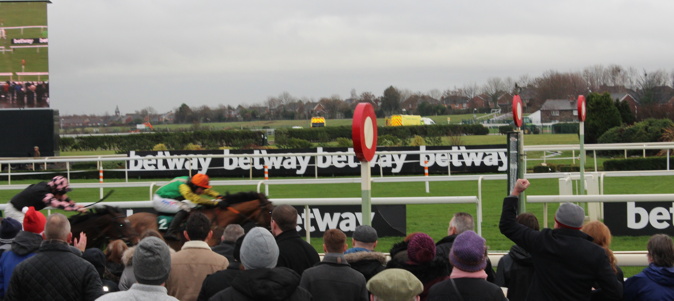How To Bet Each-Way On The Grand National
 If you are reading this page you probably don’t bet very often on horse racing and you likely only place a bet on the Grand National race each year. The question that many people ask themselves when they do bet on the National is whether they should bet on a horse to win or bet on it each-way.
If you are reading this page you probably don’t bet very often on horse racing and you likely only place a bet on the Grand National race each year. The question that many people ask themselves when they do bet on the National is whether they should bet on a horse to win or bet on it each-way.
The Grand National is one of the hardest events in the world for horses to compete in with a distance of over four and a quarter miles with no less than 30 fences to be jumped, some nearly 6 feet high. Up to 40 horses can run in the race and that means it can be a bit of a lottery picking the winner (aptly, the first ever winner of the race was called Lottery). In fact, only 15% of favourites have won the Grand National and the average odds of the winner is well over 22/1. Therefore, a lot of people that do bet on the National like to bet each-way, to both increase their chances of winning something and to get more enjoyment from the race.
Each-way betting is also popular for the National because the average odds of the horses are much bigger than typical horse races, making these bets more enticing. Here we look at how each-way bets work, how they are different to win-only bets and what you can expect to get back if you do place an E/W wager on the big race. We also look at the odds and number of places you can expect to get.
What Is An Each-Way Bet?
 An each-way bet is simply a package of two bets combined together. In horse racing you can bet on a horse to win, but with most bookmakers you can bet on a horse to place too. The place bet wins if the horse finishes in the set numbers of places, including first place, but pays out at lower odds.
An each-way bet is simply a package of two bets combined together. In horse racing you can bet on a horse to win, but with most bookmakers you can bet on a horse to place too. The place bet wins if the horse finishes in the set numbers of places, including first place, but pays out at lower odds.
You could wager an each-way bet by placing one bet on a horse to win and another bet on a horse to finish in the places. In reality it is far easier to just place a bet e/w.
Therefore, an each way bet is two bets requiring two stakes. If you bet £5 each-way you are placing a £5 bet on a horse to win and a separate £5 bet on a horse to finish in the places, total cost £10 (2x £5). If the horse wins then both of these bets win, the win bet will pay out at the original odds of the horse (e.g. 10/1) and the place bet will pay out at a quarter or a fifth of those odds (e.g. 5/2 or 2/1). If the horse finishes in the places but doesn’t win the win-only bet loses but the place bet will still win.
How Many Places and What Odds Should You Get?
 The customary each-way terms for Handicaps, Nursery and Rated Stakes Handicap races with 16 or more runners is to pay 4 places at 1/4 the odds. This is the category the Grand National falls into.
The customary each-way terms for Handicaps, Nursery and Rated Stakes Handicap races with 16 or more runners is to pay 4 places at 1/4 the odds. This is the category the Grand National falls into.
The National is, however, a special race and because of that the betting brands will compete for your custom by offering more places. When betting on the race you should be looking for at least 5 places, although many will offer 6 places these days. In 2019 Unibet offered 7 places on the Grand National.
It is generally better to wait until the day before or the day of the race to get the best each-way terms. If you bet in advance each-way you may end up with less places than you can get nearer the time. If you also bet on the day you will get best odds guaranteed too, meaning if you back a horse at say 10/1 but by the time it starts the race it’s ‘starting price’ is 12/1 you will get the better odds automatically. It also means if your horse doesn’t run for any reason you will get your stake back (although some bookies run non-runner-no-bet for advance wagers too, known as ante-post bets).
As standard you should be looking for a quarter of the odds for the place bet.
Each-Way Bet Examples

Odds are important when you bet each-way, just because you place these bets doesn’t mean you will get all of your stake back if the horse places but doesn’t win.
Here are a set of examples covering horses with short medium and long odds backing the horse £10 each-way (£20 total) with 1/4 total odds for a place:
- You back the favourite at 4/1. If the horse wins you get £50 for the win bet (£40 winnings and £10 stake back) and a quarter of those winnings for the place (£10 winnings plus your stake back). In total you get £70 back, £50 winnings and £20 stake. If the horse places only you will get back £20 from the place bet, this means you break even.
- You back a mid-range horse at 15/1. If it wins you get £160 (£150 winnings + £10 stake) and a quarter of that for the place, £47.50 (£37.50 + £10 stake), in total that makes £207.50 (£197.50 winnings + £20 stake). If the horse places but doesn’t win you get £47.50 back, still leaving you with a £27.50 profit.
- You back a long odds horse at 100/1. If it wins you get £1010 (£1000 winnings + £10 stakes) and a quarter for the place, £260 (£250 winnings + £10 stake), in total that would be £1270. If the horse places only you still stand to get back £260 giving you a profit of £240.
Effectively using the above examples you need to back a horse at 4/1 or more to ensure you at least break even if the horse places but doesn’t win. That isn’t too hard in the National though as it is rare for the favourite to be 4/1 or less.
Can You Bet On A Horse To Place Only?
 If you think a horse might finish in the places but has almost no chance of winning you don’t need to place an each-way bet, you can simply do one bet on a horse to place. This means you only have one stake instead of two.
If you think a horse might finish in the places but has almost no chance of winning you don’t need to place an each-way bet, you can simply do one bet on a horse to place. This means you only have one stake instead of two.
As with the each-way bet you will get usually a quarter of the odds with 4-7 places, depending on the bookie you are betting with. This can save you money if you prefer to bet on horses to place rather than to win.
Enhanced Each-Way
Many sites now offer enhanced each-way terms as a special market you can opt for. The idea is you can trade the odds for more places. The site I use for this is bet365.
For example, instead of betting on a horse at 40/1 with 5 places you could bet on the horse at 35/1 with 6 places or 28/1 with 7 places, etc. This means you can cover more places with your bet but by sacrificing the amount you will get back if the horse does place.
This is useful if you are backing longer-odds horses, where you can afford an odds reduction, and you think they could place but are more likely to be in the lower placing compared to the higher places.



